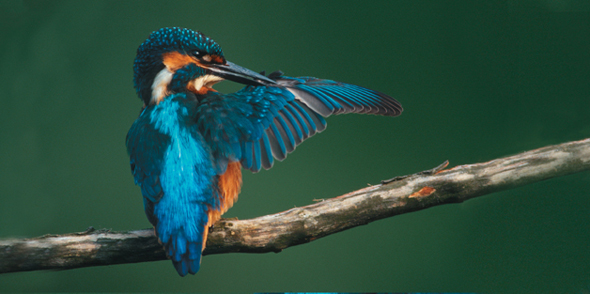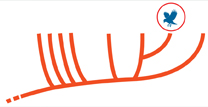Birds

Today, only birds have feathers. These delicate, intricately interlocking and beautiful structures keep birds warm and cool and enable most to fly.
Common Kingfisher

KEY CHARACTERISTICS OF BIRDS
Birds, once placed in a class of their own, are now recognized as endothermic reptiles with feathers and hard-shelled, amniotic eggs that are descended from dinosaurs. Birds have two scaly legs and front limbs modified into wings, which enable most species to fly.
Feeding and Digestion No teeth; bills adapted to widely varied foods, including insects, seeds, fruits, nectar, fish, meat; organs of the digestive system include crop, gizzard, cloaca
Circulation Two loops with four-chambered heart; separation of oxygen-rich and oxygen-poor blood
Respiration Constant, one-way flow of air through lungs and air sacs increases the efficiency of gas exchange and supports high metabolic rate
Excretion Kidneys remove nitrogenous wastes from blood, converting them to uric acid, which is excreted through cloaca
Response Brain with large optic lobes and enlarged cerebellum; highly evolved sense organs including, in some species, eyes that can see ultraviolet light
Movement Skeleton made up of lightweight, hollow bones with internal struts for strength; powerful muscles; most fly
Reproduction Internal fertilization via cloaca; amniotic egg with hard, brittle shell; depending on species, newly hatched young may be precocial—downy-feathered chicks able to move around and feed themselves, or altricial—bare-skinned and totally dependent on their parents
• A Look Back in Time
Birds of a Feather
Fossils recently discovered in lake beds in China have greatly expanded our understanding of bird evolution. One exciting discovery was that of a four-winged dinosaur named Microraptor gui from about 125 million years ago. Microraptor gui, which was related to Tyrannosaurus rex, had feathers on both its wings and its legs, so some researchers hypothesize that it flew like a biplane! This and other fossils show that several lineages of dinosaurs and ancient birds evolved various kinds of feathers over millions of years.

Artist's conception of Microraptor gui
Table of Contents
- Formulas and Equations
- Applying Formulas and Equations
- Mean, Median, and Mode
- Estimation
- Using Measurements in Calculations
- Effects of Measurement Errors
- Accuracy
- Precision
- Comparing Accuracy and Precision
- Significant Figures
- Calculating With Significant Figures
- Scientific Notation
- Calculating With Scientific Notation
- Dimensional Analysis
- Applying Dimensional Analysis




